I've missed this blog. The time between now and my last post has been spent adjusting to new work responsibilities and a new apartment. I've learned so much, and truly feel present, confident and eager to make an impact. I'm excited for the future.
For the past few months, I've also been helping a dear friend create decorations for her July 5 wedding. We have very big plans with a strict budget, and want the wedding to be as much of an artistic statement as a declaration of united love. Of course, it is important for me to incorporate as many handmade elements as possible. Some of the decorations that I've been making are tissue paper flowers. This is a super-easy technique that doesn't require much time at all.
In order to make them, you'll need:
- a pack of tissue paper
-
Modge Podge glue
- scissors
- masking tape
- a tree branch
- a scrap piece of designed paper. I used pieces of old music sheets.
The pack I used contained 10 sheets of tissue paper, and measured 20 inches by 24 inches when unfolded and laid flat. Without unfolding it, the first thing I did was cut it in half.
I then put one half to the side, and fully opened the other half.
I vertically cut this piece in half again, using the middle paper crease as a guide.
One of these halves, which now measure 12 3/4 inches by 10 inches, will be used to create one flower. As you see, though, there's a lot of tissue paper left over. A pack of tissue paper in the size and amount I used should yield four flowers.
The half that you cut should also contain the appropriate number of individual sheets of tissue paper that you'll need. For one flower, you'll need about nine sheets.
To make the first petal, take one of the sheets of tissue paper and fold it in half lengthwise, with the pre-made creases horizontal. My folded piece of paper measured 6 3/8 inches by 10 inches.
Next, hold the folded half at the bottom, approximately in the middle.
Gently begin bunching either side together and upward, being careful not to rip the paper.
You should end up with a cone-like shape.
Next, twist the bottom, which will serve as the base of your flower petal. Twist tightly, but again be careful not to rip the paper.
This is what one petal should look like when completed:
Repeat the above steps with the other eight pieces of paper.
Then, apply glue to the twisted base of one petal. You only need to apply glue to one side of the base. I used my finger to my apply the glue, but of course you're welcome to use a brush.
Adhere the glued petal to another one, then apply glue to the other petals in the same way, in order to create your bouquet. To give the bouquet as much of a uniform shape as possible, adhere the petals to the top and bottom of the petal bases, as well as the sides.
If you prefer to have rounded petal tips instead of pointed ones, simply take a pair of scissors and curve each of the exposed tips you see.
Next, add "stem" to the flower by attaching it to a small tree branch using masking tape, wrapping the tape around the branch and glued petal bases.
You could then glue a small piece of decorative paper around the attached masking tape, in order to cover it.
Follow all of the above steps using tissue paper in multiple colors, in order to create a lovely bouquet!























































